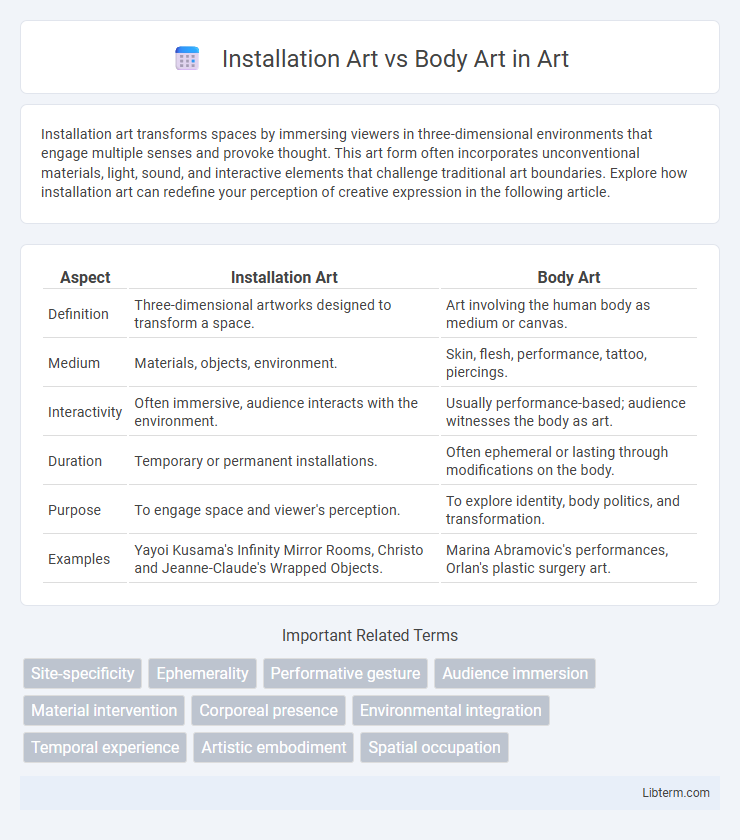Installation art transforms spaces by immersing viewers in three-dimensional environments that engage multiple senses and provoke thought. This art form often incorporates unconventional materials, light, sound, and interactive elements that challenge traditional art boundaries. Explore how installation art can redefine your perception of creative expression in the following article.
Table of Comparison
| Aspect | Installation Art | Body Art |
|---|---|---|
| Definition | Three-dimensional artworks designed to transform a space. | Art involving the human body as medium or canvas. |
| Medium | Materials, objects, environment. | Skin, flesh, performance, tattoo, piercings. |
| Interactivity | Often immersive, audience interacts with the environment. | Usually performance-based; audience witnesses the body as art. |
| Duration | Temporary or permanent installations. | Often ephemeral or lasting through modifications on the body. |
| Purpose | To engage space and viewer's perception. | To explore identity, body politics, and transformation. |
| Examples | Yayoi Kusama's Infinity Mirror Rooms, Christo and Jeanne-Claude's Wrapped Objects. | Marina Abramovic's performances, Orlan's plastic surgery art. |
Defining Installation Art: Concepts and Characteristics
Installation art transforms spaces using multi-sensory experiences that engage viewers through immersive environments. It often incorporates diverse materials, including found objects and technology, to challenge conventional art boundaries and evoke emotional or intellectual responses. Characteristics include site-specificity, spatial interaction, and an emphasis on context where the artwork and its surroundings form a unified narrative.
Understanding Body Art: Origins and Evolution
Body Art originated in the 1960s as a radical form of self-expression involving the human body as the primary medium, often blurring the lines between art and life. Influential artists like Carolee Schneemann and Bruce Nauman pushed boundaries by exploring themes of identity, politics, and corporeality through performance, tattooing, and piercing. The evolution of Body Art reflects a shift towards immersive and interactive experiences, distinguishing it from Installation Art which typically transforms physical spaces rather than the body itself.
Historical Development: Tracing Both Movements
Installation Art emerged in the 1950s and 1960s as artists sought to transform exhibition spaces into immersive environments, with pioneers like Allan Kaprow and Claes Oldenburg redefining the relationship between audience and artwork. Body Art gained prominence in the 1960s and 1970s, rooted in performance art and conceptual art movements, with figures such as Marina Abramovic and Chris Burden using the human body as a primary medium to challenge traditional art forms and explore identity. Both movements evolved as responses to the limitations of conventional art, emphasizing experiential and ephemeral qualities that continue to influence contemporary artistic practices.
Key Elements: Space in Installation vs. Body as Canvas
Installation art emphasizes the manipulation of physical space to create immersive environments that engage viewers through scale, light, and spatial arrangement. In contrast, body art uses the human body itself as the primary canvas, transforming skin, movement, and presence into dynamic expressions of creativity and identity. The key element distinguishing these forms is how installation art shapes external surroundings, whereas body art internalizes space by integrating artistic expression directly onto or through the performer's body.
Influential Artists in Installation Art
Installation art, characterized by immersive environments often site-specific, has been profoundly shaped by influential artists such as Yayoi Kusama, known for her infinity mirror rooms that explore themes of repetition and self-obliteration. James Turrell's use of light and space challenges perception and transforms architectural spaces into meditative experiences, while Olafur Eliasson's large-scale installations incorporate natural elements to engage viewers with environmental issues. These artists have expanded the boundaries of installation art by integrating sensory engagement, spatial alteration, and conceptual depth, distinct from the performative and ephemeral nature of body art.
Pioneers and Icons in Body Art
Pioneers of Body Art such as Marina Abramovic and Chris Burden revolutionized the genre by using their own bodies as primary mediums to explore themes of endurance, pain, and identity. Abramovic's landmark performances like "Rhythm 0" pushed the limits of audience interaction and vulnerability, while Burden's "Shoot" famously tested physical and psychological boundaries. These iconic artists established foundational practices that continue to influence contemporary body artists worldwide.
Audience Interaction: Immersion vs. Intimacy
Installation Art transforms spaces into immersive environments, encouraging audience members to engage physically and sensorially within the artwork's surroundings. Body Art centers on intimate interaction, using the artist's own body or participant bodies as a medium to evoke personal connection and emotional response. Both forms emphasize audience involvement but differ in scale and sensory engagement, with Installation Art prioritizing spatial immersion and Body Art fostering direct, embodied intimacy.
Materiality and Mediums: Contrasts and Crossovers
Installation art emphasizes spatial engagement through diverse materials like found objects, light, sound, and digital media, creating immersive environments that transform viewers' experiences. Body art centers on the human body as both medium and material, often using paint, tattooing, piercing, and performance to express identity, vulnerability, and temporality. Both forms challenge traditional art boundaries by integrating materiality and embodied interaction, with crossovers evident in live installations where the artist's body becomes part of the spatial narrative.
Cultural and Social Impact of Both Art Forms
Installation Art transforms space and environment, inviting viewers to engage physically and emotionally, often addressing social issues like consumerism, identity, and environmental concerns. Body Art, using the human body as a canvas or medium, challenges cultural norms related to identity, gender, and autonomy, provoking dialogue on personal and societal boundaries. Both art forms disrupt traditional art consumption, fostering deeper cultural reflection and social awareness through immersive, experiential encounters.
Future Trends: Installation Art and Body Art in Contemporary Practice
Future trends in Installation Art emphasize immersive, technology-driven environments incorporating augmented reality and interactive digital media to engage audiences in multisensory experiences. Body Art continues to evolve with bio-art and wearable technology, exploring themes of identity and transformation through live performance and digitally enhanced bodily expressions. Both practices increasingly intersect, blending spatial installations with live, performative elements to challenge conventional boundaries of art and viewer interaction.
Installation Art Infographic

 libterm.com
libterm.com